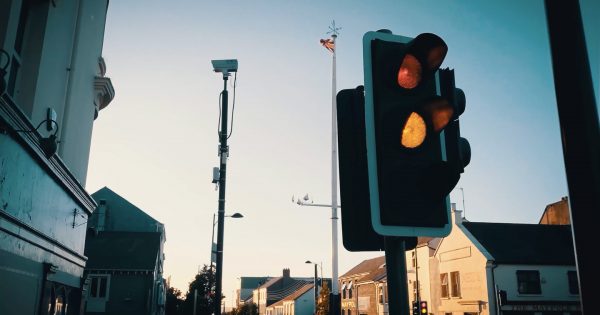The LG V30 smartphone just came out, and with a big ambition in a noisy marketplace—to position itself as the phone for shooting video, as expressed in its tagline, “Find your frame.”
Luckily it’s got a dragon enlisted. The V30’s headliner is David Franco, director of cinematography for Game of Thrones, Westworld and Minority Report.
Who better to take your video features out for a spin?
Below is a “day in the life” video that Franco created, using nothing but the LG V30. Industrial workspaces contrast with sun-dappled streets, where violinists play for coins. Whimsical shots of Franco’s children, eating crepes or leaping, join amplified social moments, like concerts or sports games. An undressed set lies waiting.
There’s nothing special here. But the video quality is beautiful, the shooting approaches diverse. It’s morsels of life on their way to becoming memories. We’re reminded of videos we sometimes find on our phones, which take us by surprise and throw us back to places we somehow forgot—a memory special enough to shoot, so quickly filed away that its chance recovery is bittersweet.
While scouting for GoT’s last season—somewhere in Iceland (though the conversation started in Belfast)—Franco found time to answer a few questions from Adweek about shooting video on the V30, life beyond work and his favorite GoT scenes to make.
Adweek: Tell us how the concept of “finding your frame” is relevant to you.
David Franco: “Find your frame” is all about highlighting those inspiring everyday artistic moments and the creative process behind them. As a DP [director of photography/cinematographer], I obviously have to do this for my job, but people don’t realize that they do this all the time when shooting videos, taking pics, all from their smartphone.
When trying to capture that perfect shot before you press record, I think within that moment everyone has their own creative perspective. For me, I’m literally “finding my frame” all the time, both at work and in my daily life.
Why the LG V30?
When I’m location scouting, I rarely carry a DSLR nowadays. I use my smartphone to quickly document everything. It helps me with numerous applications that take proper measurement of the exact positioning of the sun, ocean, skyline, etc., at a given date. Plus, outside of work, I just love recording things that inspire me in my daily life—nature, my kids, exploring local areas, so I really need a phone that doesn’t just have an easy-to-use camera, but also one with amazing quality for my photos and videos.
That’s why I partnered with LG to launch the new V30 smartphone, which was designed specifically for cinematic videography. As a DP, I know the importance of video quality, so having a phone that produces rich, high-quality videos conveniently is great. I can say from personal experience that this phone has raised the bar, bringing professional video features to everyone.
What does your Day in a Life video convey to people about your world, work and process?
Like anyone else, I have my smartphone with me at all times. But without a DSLR or camcorder, I never got that high-quality with my smartphone, so I was really impressed with the V30 when I first tried it out. I got the chance to shoot the things that inspire me in my daily life—nature, my kids, exploring local areas—with the V30, earlier than anyone else.
In terms of my process when shooting this video, I was able to combine my professional background with the phone’s video capabilities. For example, the V30’s Cine Video Mode takes care of coloration with Cine Effect. This makes it a piece of cake to select the right color scheme, depending upon your scenery and what kind of mood you want to impart in the moment. You can also control the intensity of the colors and even give it a vignette effect.
Any technical insights you can share? How can fans “find their frame” in real life?
The big mandate for Games of Thrones and Westworld is forgetting about the conventional “TV frame of mind” and thinking more in the lines of big canvas film, not being afraid of a wide vista shot and doing as much as possible in visual storytelling.
Each scene could mandate different technical requirements, but what is communicated is finding a great landscape, integrating all the action to taking full advantage of the dramatic setting. So figuring out well in advance how to stage and position the camera properly to the set and sun position is a key ingredient.
That’s certainly a tip for fans on how to “find your frame.” I always film and shoot with something specific in mind, giving careful consideration to all objects and the overall landscape in order to find that ideal shot.
Give us the scoop on GoT. What’s the craziest place or scene you’ve ever had to shoot? Why?
Probably the “top of the wall” scene in season 4 when we had to recreate an ice structure and then shoot all those battle scenes where the Wildlings attack. It was a 150-foot set that’s supposed to be snowy, icy and at high altitude. But the craziest in the best way was to shut down the garden of Spain and have it all to ourselves. That was very special.
Anything you can tell us about future scenes, either for GoT or Westworld?
I am not involved in season 2 of Westworld, and I can’t say much of the future of Games of Thrones (it’s top secret!). Winter is here, and I can tell you that the season will be bigger and better than ever.



















![[Book Review] The Blade Itself (The First Law Trilogy) by Joe Abercrombie](https://bendthekneegot.com/wp-content/uploads/2018/01/1516047103_maxresdefault-218x150.jpg)


















